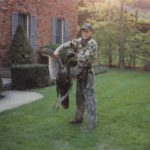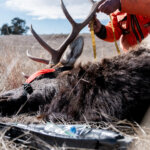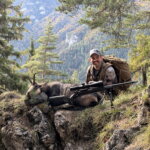Just like our trip to Kodiak fifteen years prior, Dad and I were set up to do a combo hunt for waterfowl and blacktail. Earlier in the year, when we booked our hunts, we were told that the blacktail deer numbers were down on the island due to a bad winter kill the year before. Remembering the hundreds of blacktail we’d seen on our past hunt on the island, we were not overly concerned. We were also after sea ducks on Kodiak, and our primary target was a Barrow’s Goldeneye. Kodiak has the highest concentration of Barrow’s Goldeneye anywhere in North America, making it the go-to destination and our best opportunity to check that one off the list. If we didn’t get one on this trip, we would have to schedule another trip back to Kodiak later in the season. There are other species of sea ducks on Kodiak, but I’d have opportunities for them on trips to Maine and Rhode Island later in the season.
We left Fargo early in the morning and arrived in Kodiak City mid-afternoon. Thanks to the time zones we crossed, I was hopeful to get in a short evening hunt. All commercial transportation, either by airline or ferryboat, goes through the city of Kodiak. With a population of nearly 6,000 people, the city had changed and grown since my last visit. More than fifteen years before this trip, I was there on a family hunt for blacktail (Sitka) deer and waterfowl. On that hunt we stayed in Larsen’s Bay, one of the smaller of the six communities on the island. Three things stand out from that trip:
1. We must have seen hundreds of blacktail deer—we each had three licenses and we filled them all.
2. The duck shooting was impressive—we set up on points that stuck out in the bay near our lodge and shot passing sea ducks.
3. The size and numbers of the Kodiak brown bears we saw and heard amazes me to this day.
Just like our trip to Kodiak fifteen years prior, Dad and I were set up to do a combo hunt for waterfowl and blacktail. Earlier in the year, when we booked our hunts, we were told that the blacktail deer numbers were down on the island due to a bad winter kill the year before. Remembering the hundreds of blacktail we’d seen on our past hunt on the island, we were not overly concerned. We were also after sea ducks on Kodiak, and our primary target was a Barrow’s Goldeneye. Kodiak has the highest concentration of Barrow’s Goldeneye anywhere in North America, making it the go-to destination and our best opportunity to check that one off the list. If we didn’t get one on this trip, we would have to schedule another trip back to Kodiak later in the season. There are other species of sea ducks on Kodiak, but I’d have opportunities for them on trips to Maine and Rhode Island later in the season.
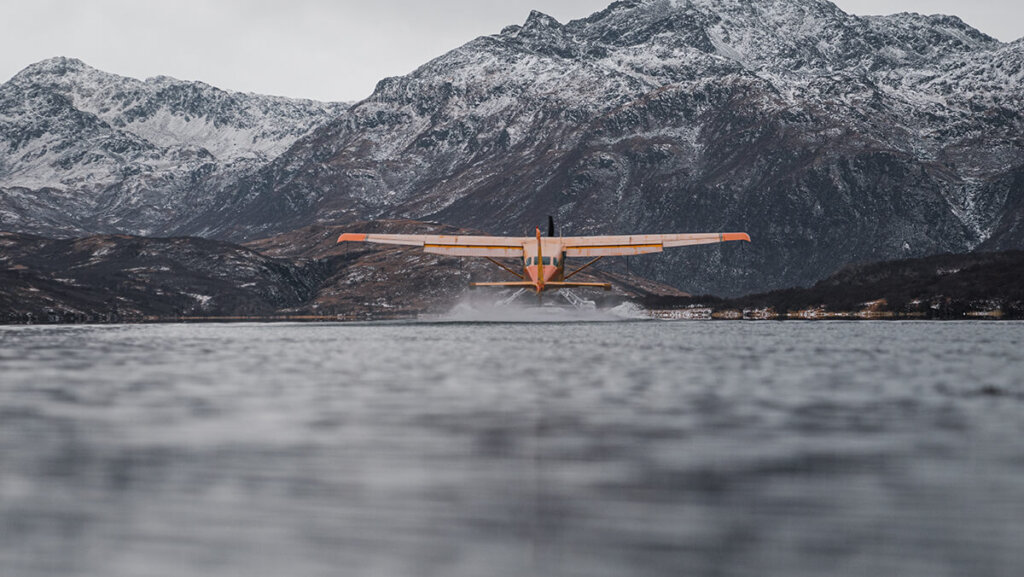
Our outfitter on the island, Brian, has been there since the early 1980s. He started as a guide for another outfitter but worked hard and is now the owner of his own operation. He outfits primarily for fishing, deer, mountain goats, and brown bears. Waterfowl hunts are an add-on that hunters and fishermen can take advantage of. He has a shotgun and shells available for anyone possessing a waterfowl license who wants to give it a try. It was a thirty-minute floatplane ride from the docks in the city of Kodiak to our camp. When we arrived, Brian explained that the previous week had been much colder than normal—this was becoming an unfortunately common theme of my Waterfowl Slam. As a result, there was more frozen water, and the unusual amount of icy snow would make deer hunting “interesting,” as Brian put it. No matter—I have learned to expect the unexpected over the years. With about an hour of shooting light left, I asked if we could hunt ducks the rest of the day. Brian gave the go-ahead and we quickly changed into warm hunting gear.
Brian showed us his unique duck hunting spot, which was about 150 yards from the camp. He has been using it for more than twenty-five years and it’s definitely an interesting spot that requires a different hunting technique from what I’m used to. The spot is a rocky point that sticks out into the bay. The point is on a much narrower section of the bay, so the water area the ducks fly over isn’t as wide as in most areas. As a result, sea ducks traveling back and forth and up and down the bay are sometimes closer to the shore than normal. Brian’s technique is to put two or three strings of sea duck decoys out while the hunters hide in the rocks.
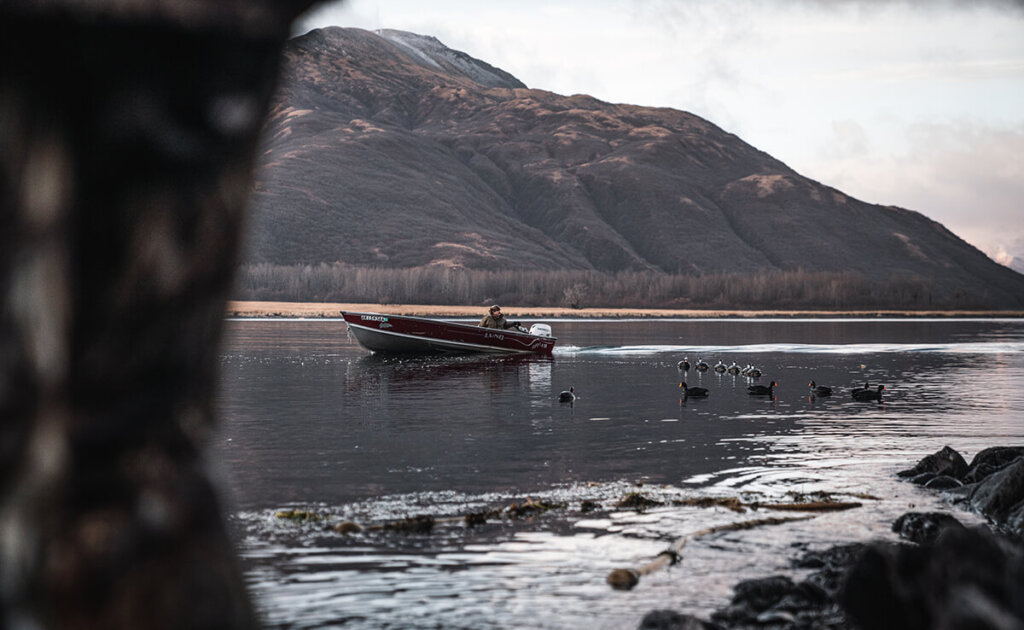
The spot is especially good early in the morning and late in the day, as hunters can take passing shots when the sea ducks are on the move. They come screaming through and the hunter needs to identify the species and sex before taking a shot. Alaska has daily and seasonal limits for various waterfowl species, making quick identification extremely important. That first evening, Dad and I started to learn on-the-fly sea duck identification and were able to take a couple of shots. It was Dad’s seventy-third birthday and we’d hoped to get him a couple birthday ducks. I was able to connect on a Common Scoter hen, but Dad came up empty-handed. One thing became very apparent to us during that first hunt on the point—sea ducks have excellent eyesight. They are extra-cautious and easily spooked. A hunter’s slight movement, an unnatural color exposed, or even a quick flash of skin or the shine off of a shotgun immediately changes their path. One wrong move and the ducks are instantly just outside of ethical shotgun range.
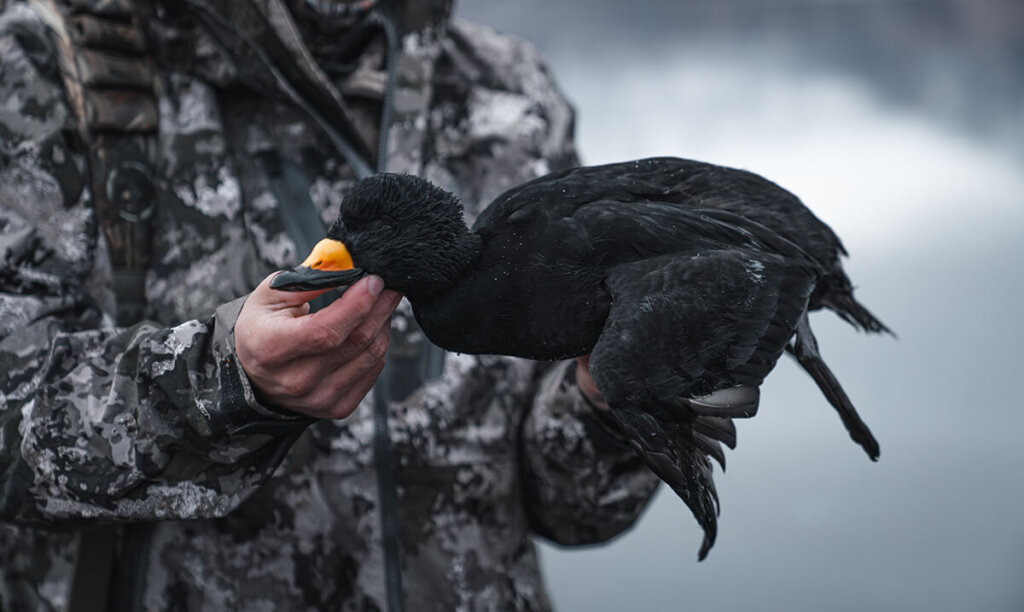
On our first full day with Brian, while his normal hunters would be heading out deer hunting, Dad and I were getting ready to go duck hunting. Our first priority was sea ducks, particularly a Barrow’s Goldeneye, so back to the point we went for a morning hunt. We limited our shots and continued our crash course in quick species identification. The ducks were screaming by, providing us only a split second to identify and shoot. There’s no room for error with this type of hunt. Alaska’s species and sex bag limits are in place for conservation purposes and making a mistake here is not an option. As the morning wore on, Dad and I became more comfortable with identifying species and sex. Dad ended up shooting a drake and hen Common Scoter and a hen Barrow’s Goldeneye. I connected on two drake Common Scoters. With yesterday’s hen Common Scoter, I was only able to shoot one more Common Scoter. We also each took a drake Harlequin, so with our three each from Cold Bay, we were both at our season’s limit of four for Alaska. As you could imagine, drake Harlequins landing in our string of decoys was a common occurrence the remainder of our Kodiak hunt.
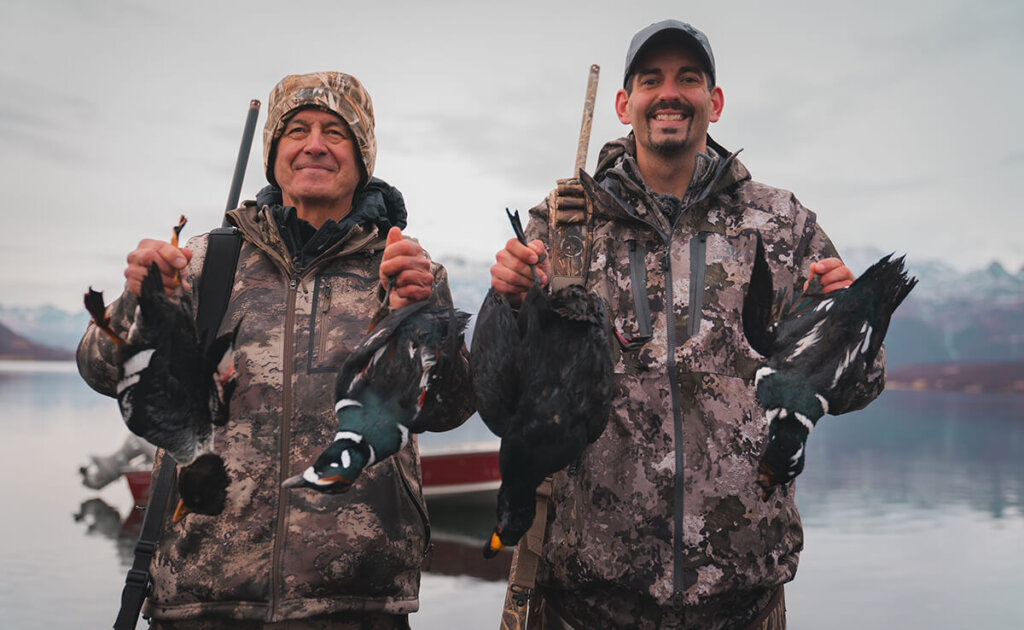
That afternoon, we decided to take a boat to a nearby bay that was home to some Surf and White-winged Scoters. We used a technique called drift shooting in that bay. Brian took us in his boat near the upper end of the bay and turned the motor off. With the tide moving out, we just drifted, hoping some unsuspecting sea ducks would pass by within range. We did the drift technique for over two hours and took a few shots at the Scoters we were seeking, but were unable to connect, as the ducks flared away from the boat just as they came within range.
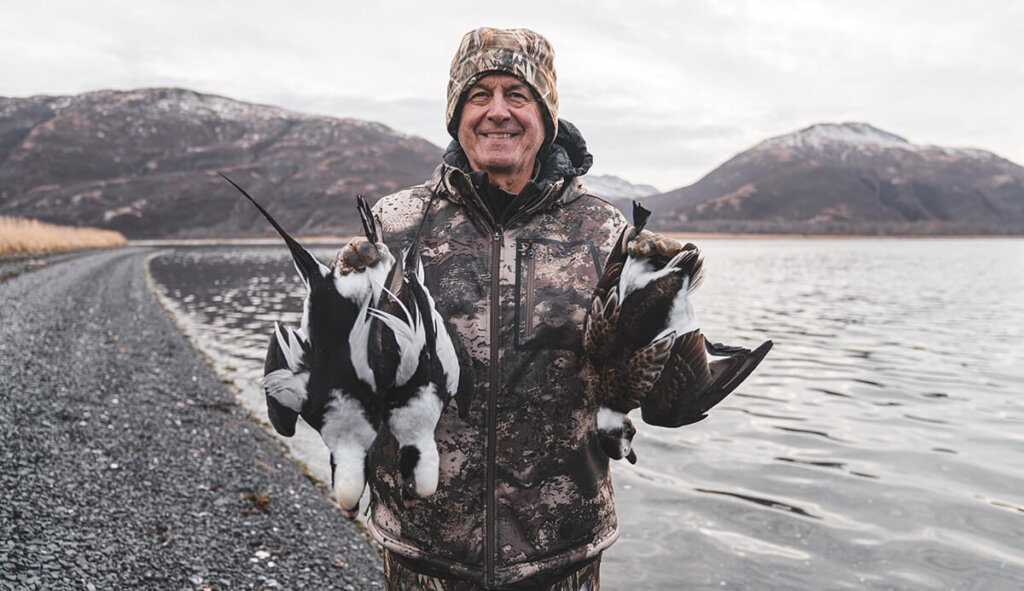
We decided to call it quits in that bay and try the drift technique back in our home bay. Earlier in the day, we had spotted a large group of Long-tailed (formerly known as Old Squaw) and felt that drifting might be an effective way to hunt them. I was on the right side of the boat and Dad was on the left. As we drifted almost within shotgun range, they lifted and flew away from us. The disappointment was short-lived, however. For no apparent reason, they banked left and flew across on Dad’s side of the boat at about fifty yards. Dad fired and one dropped. Then a second one fell, followed by a third. With one shot, two drake Long-tailed and a hen Long-tailed were stone-cold dead floating on the water. Brian said it was rare to see the ducks come around like that: “We could do that a hundred times and only once would the ducks circle back.” Dad’s single shot secured him three out of his four Alaska Long-tailed bag limit for the year. Dad had a phenomenal day—those three Long-tailed combined with his three ducks in the morning put him at six of his seven-sea-duck daily limit. We decided to finish the day—and hopefully get Dad his seventh sea duck—back at the point. We continued our identification training, and those pesky Harlequins were everywhere. A group of Long-tailed did fly by too, but they were just out of my range. No ducks were taken that evening.
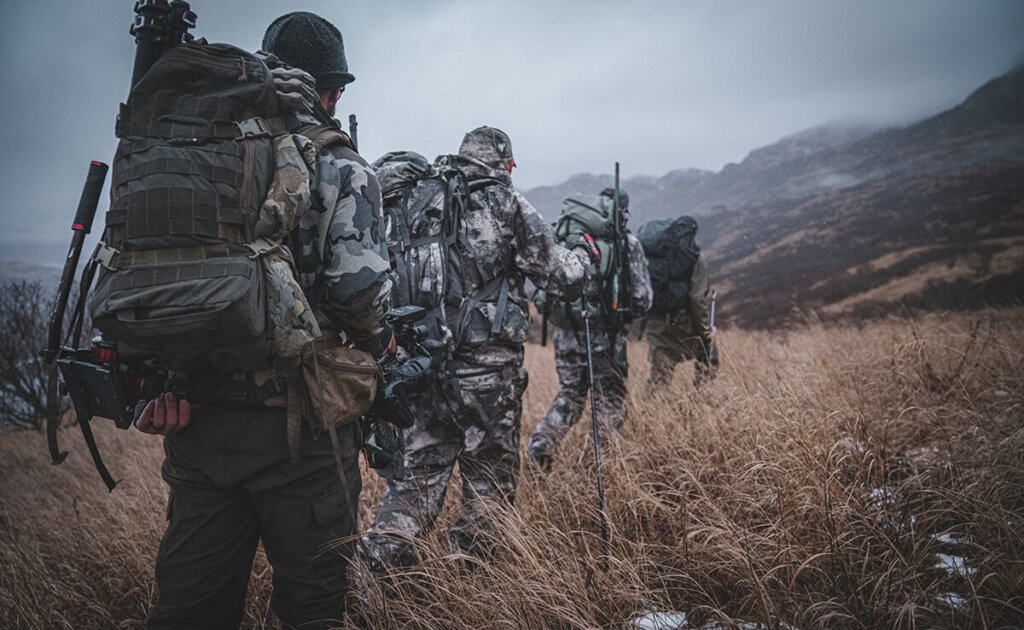
We decided to hunt blacktail for our second full day on Kodiak. It was rainy and cloudy. And in hindsight, we should have deer hunted the previous day and taken advantage of the good weather. That rainy day would have been better for sea duck hunting at the point or drift hunting.
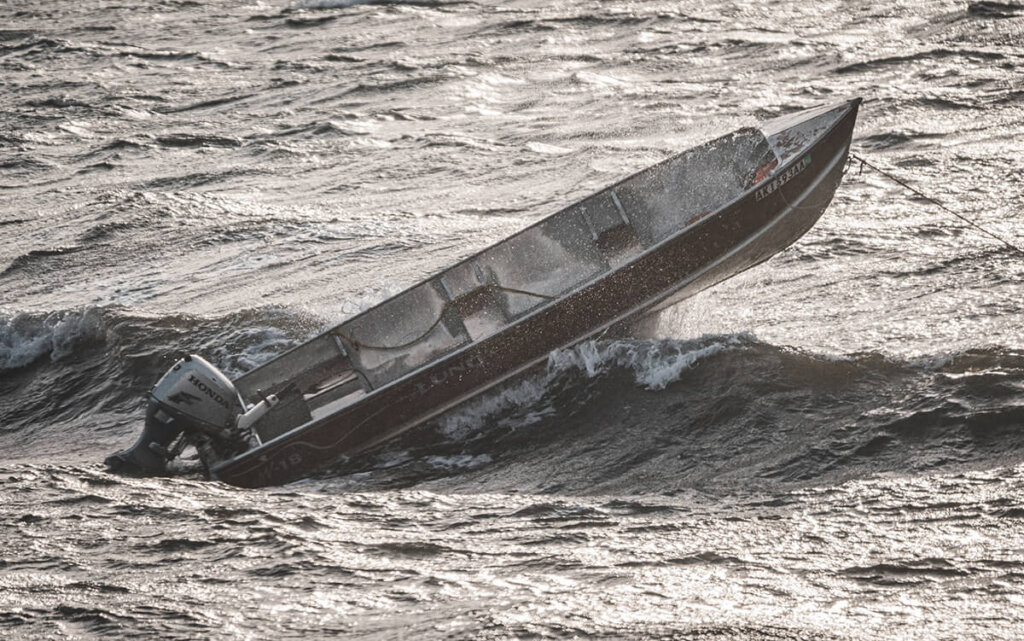
On the third day, the weather turned worse. The wind was over sixty miles per hour, and the rain was steady. The boat couldn’t be used, so I continued to hunt for deer near camp. My deer guide, Adam, and my two camera guys and I climbed the upland behind our camp and spent most of the day looking for a shooter buck. It was brutal up there between the wind and cold. We finally saw two does in the distance, but it wasn’t long after that when we decided to head back to the warmth of our fire at camp.
The weather had greatly improved the next morning, so we were back at the point. Dad and I were confident in our sea duck identification, and we weren’t having nearly as many “damn it” moments—which happened when we realized the duck that had just passed was one, we could have taken. It was a successful morning. I shot a hen and a drake Barrow’s Goldeneye. My primary Waterfowl Slam goal for Kodiak had been achieved. It was a relief knowing I wouldn’t have to schedule an extra hunt back to the island to get that species checked off the list.
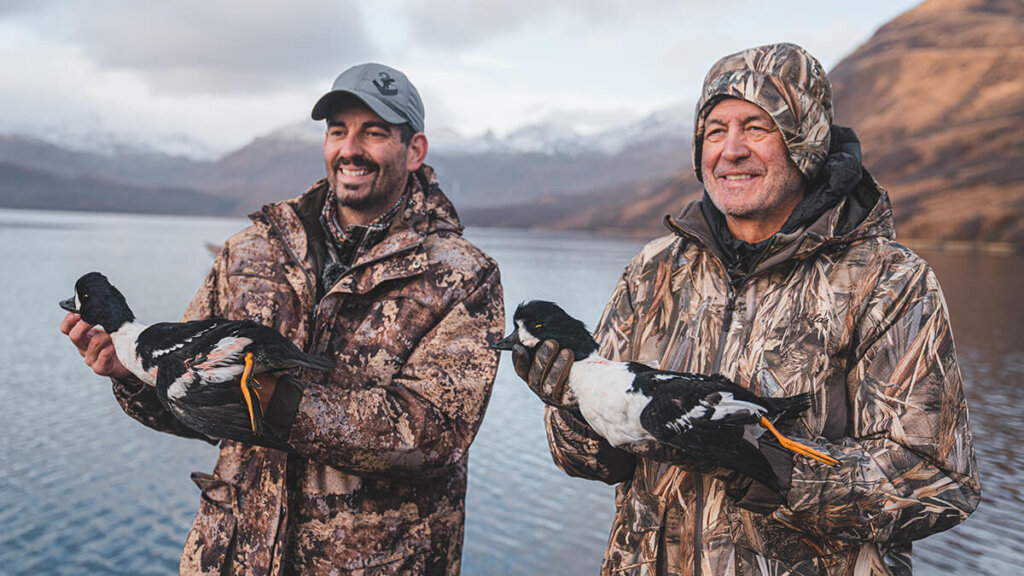
The weather was good at camp for our last full day on the island, so I decided to go blacktail hunting again while Dad hunted the point. I went back to the head of the bay, and as soon as I reached the top of the upland, the fog closed in. I saw a good buck from a distance and tried making a sneak on him to get within muzzleloader range. Through the fog, I lost him and never picked him back up. Dad had similar luck duck hunting the point. He only saw sea ducks that he wasn’t able to take any more of.
Our flight off Kodiak Island left late the next morning. We decided we had time to take one last hunt on the point in our final hours on the island. Dad and I both shot drake Barrow’s Goldeneyes. None of the other sea ducks we were looking for came within range.
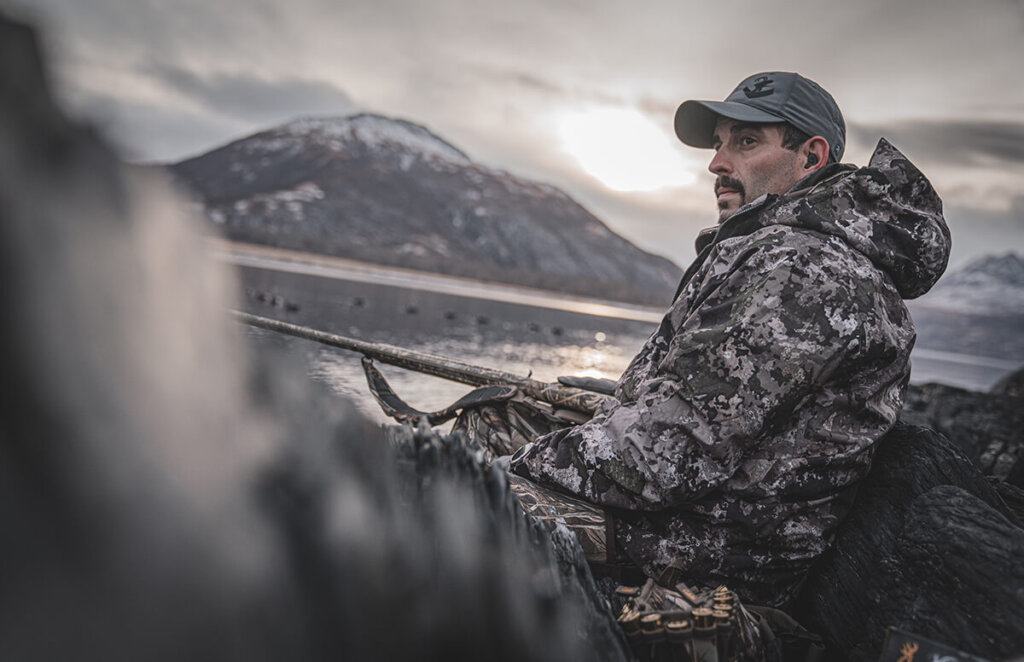
Looking back at Kodiak, the deer hunting was tough because of the bad winter kill the year before. The weather could have been better for hunting the uplands as well. Duck hunting at the point was excellent, however, and more than made up for the poor blacktail hunt. If our drift boat would have been better camouflaged and not shiny aluminum, we would have done much better when drift shooting—we had so many sea ducks come almost close enough to take a shot before they’d catch a glimpse of the shine coming off our boat and flare. Dad and I both felt we’d gotten pretty good at duck identification, and I’d bagged my primary target for Kodiak, the Barrow’s Goldeneye. Although it wasn’t a successful blacktail hunt, it was certainly a successful Waterfowl Slam hunt and brought my total to sixteen of the forty-three species.


